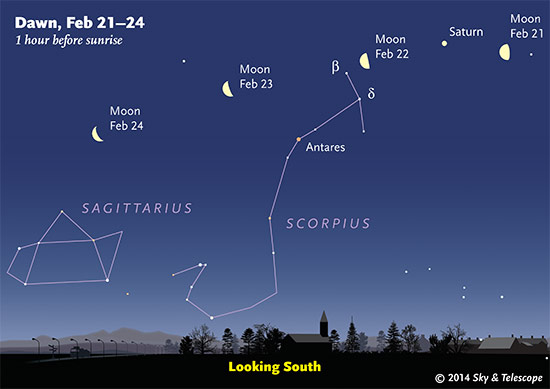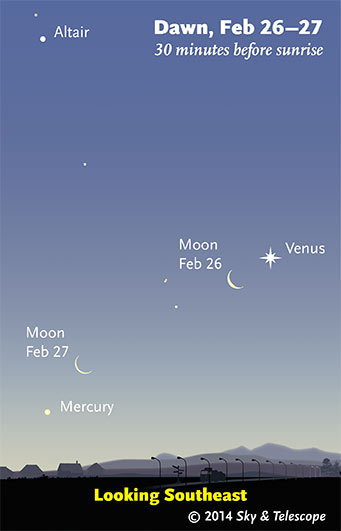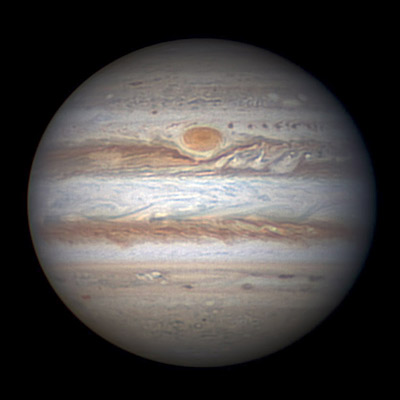Friday, February 21
- Capella passes closest to straight overhead (for skywatchers at mid-northern latitudes) around 7 p.m. now, depending on how far east or west you are in your time zone. Whenever Capella crosses highest overhead, Rigel in Orion's leading foot marks due south over your landscape.
- Saturn glows to the right of the Moon as dawn begins on Saturday morning the 22nd, as shown below. And look lower left of the Moon for Antares.

As the Moon wanes past third quarter, it passes Saturn and two "summer" constellations in early dawn.
.
Saturday, February 22
- This year's big, bright "Winter Diamond" — Jupiter at the top, Sirius at the bottom, and Procyon and Betelgeuse forming the two side corners — stands upright in the south around 8 or 9 p.m. now.
Sunday, February 23
- The asteroid 2 Pallas, barely past opposition, is a few degrees southeast of Alphard in Hydra. It remains at magnitude 7.0 all week as it creeps northward, visible in binoculars and small telescopes. Use the finder chart in the March Sky & Telescope, page 51.
Monday, February 24
- During dawn on Tuesday the 25th, the waning crescent Moon shines upper right of Venus in the southeast.

The thin waning crescent pairs up with bright Venus, then tougher Mercury. (The Moon is always plotted for the middle of North America. In Europe, move each Moon a quarter of the way toward the one for the previous date. In the Far East, move it halfway.)
Tuesday, February 25
- During dawn on Wednesday the 26th, Venus shines upper right of the waning Moon low in the southeast, as shown here. At the time of dawn in the Americas they appear closer together than they did on Tuesday morning.
Several hours earlier, the Moon passes right across — occults — Venus for central and western Africa, India, and parts of China and Southeast Asia (at roughly 5h Universal Time February 26th); see map and timetable.
Wednesday, February 26
- About 30 minutes before sunrise Thursday morning, scan with binoculars very low in the east-southeast (far lower left of Venus) for the superthin crescent Moon with Mercury to its lower left, as shown here (as seen from North America).
Thursday, February 27
- Sirius shines at its highest in the south by 8 or 9 p.m. Use binoculars to look for the dim open star cluster M41 straight below it by 4°. That's a little less than the width of a typical binocular's field of view.
And with a moderate to large telescope on a night of very fine seeing, this is when to try to detect the white-dwarf companion of Sirius, now 10.2 arcseconds east of the bright primary. See last October's Sky & Telescope, page 30, for tips and tricks when attempting this challeging project.
Friday, February 28
- Have you ever seen Canopus, the second-brightest star after Sirius? In one of the many interesting coincidences that devoted skywatchers know about, Canopus lies almost due south of Sirius: by 36°. That's far enough south that it never appears above your horizon unless you're below latitude 37° N (southern Virginia, southern Missouri, central California). And there you'll need a flat south horizon. Canopus crosses the south point on the horizon just 21 minutes before Sirius does.
When to look? Canopus is due south when Beta Canis Majoris — Mirzim, the star a few finger-widths to the right of Sirius — is at its highest point due south. Look straight down from Mirzim then!
- Jupiter's moon Io crosses in front of Jupiter's face from 5:56 to 8:11 p.m. Eastern Standard Time this evening. Its tiny black shadow follows behind from 7:02 to 9:17 p.m. EST. Jupiter's Great Red Spot transits the planet's central meridian around 9:09 p.m. EST.
Saturday, March 1
- Look east after dusk this week for the constellation Leo already climbing well up the sky. Its brightest star is Regulus, and the Sickle of Leo extends upper left from there. As the saying goes, Leo announces spring.
- New Moon (exact at 4:00 a.m. EST).
Want to become a better astronomer? Learn your way around the constellations. They're the key to locating everything fainter and deeper to hunt with binoculars or a telescope.
This is an outdoor nature hobby. For an easy-to-use constellation guide covering the whole evening sky, use the big monthly map in the center of each issue of Sky & Telescope, the essential guide to astronomy. Or download our free Getting Started in Astronomy booklet (which only has bimonthly maps).

The Pocket Sky Atlas plots 30,796 stars to magnitude 7.6 — which may sound like a lot, but that's less than one star in an entire telescopic field of view, on average. By comparison, Sky Atlas 2000.0 plots 81,312 stars to magnitude 8.5, typically one or two stars per telescopic field. Both atlases include many hundreds of deep-sky targets — galaxies, star clusters, and nebulae — to hunt among the stars.
Sky & Telescope
Once you get a telescope, to put it to good use you'll need a detailed, large-scale sky atlas (set of charts). The standards are the little Pocket Sky Atlas, which shows stars to magnitude 7.6; the larger and deeper Sky Atlas 2000.0 (stars to magnitude 8.5); and once you know your way around, the even larger Uranometria 2000.0 (stars to magnitude 9.75). And read how to use sky charts with a telescope.
You'll also want a good deep-sky guidebook, such as Sue French's Deep-Sky Wonders collection (which includes its own charts), Sky Atlas 2000.0 Companion by Strong and Sinnott, the bigger Night Sky Observer's Guide by Kepple and Sanner, or the beloved if dated Burnham's Celestial Handbook.
Can a computerized telescope replace charts? Not for beginners, I don't think, and not on mounts and tripods that are less than top-quality mechanically (able to point with better than 0.2° repeatability, which means fairly heavy and expensive). As Terence Dickinson and Alan Dyer say in their invaluable Backyard Astronomer's Guide, "A full appreciation of the universe cannot come without developing the skills to find things in the sky and understanding how the sky works. This knowledge comes only by spending time under the stars with star maps in hand."
This Week's Planet Roundup

Jupiter on February 19th. South is up. The Great Red Spot is smack on the central meridian, at System II longitude 208°.
Note the thin, very dark red edge of the Red Spot Hollow in which it sits, the massive white turbulence following (celestial east of) the spot in the South Equatorial Belt, the row of dark dots following the Red Spot in the very weak, thin South Temperate Belt, and the three white ovals at upper right in the South South Temperate Belt grouped like a Mickey Mouse hat. Jupiter never quits.
Mercury is deep in the glow of sunrise.
Venus (magnitude –4.8, in Sagittarius) blazes as the "Morning Star" before and during dawn; look southeast. A small telescope shows that it's a thickening crescent.
Mars (magnitude –0.3, in Virgo) rises around 10 p.m. now, a fiery blaze 6° to the left of icy Spica. The two of them are highest in the south around 3 or 4 a.m., with Spica now lower right of Mars.
In a telescope Mars has grown to about 11 arcseconds wide, big enough for good 4-inch and larger telescopes to show surface features in good seeing. See the Mars map and observing guide in the March Sky & Telescope, page 50. Mars will be 15.1? wide when closest to Earth in mid-April.
Jupiter (magnitude –2.5, in Gemini) dominates the high south during evening. Read lots about observing Jupiter telescopically in the January Sky & Telescope, or see our briefer online article Jupiter: Big, Bright, and Beautiful.
Saturn (magnitude +0.5, in Libra) rises around midnight and is highest in the south at the beginning of dawn. By then it's far left of Mars and Spica, and less far to the upper right of Mars-colored Antares.
Uranus sinks low in the west after dusk.
Neptune is hidden in conjunction with the Sun.
All descriptions that relate to your horizon — including the words up, down, right, and left — are written for the world's mid-northern latitudes. Descriptions that also depend on longitude (mainly Moon positions) are for North America.
Eastern Standard Time (EST) is Universal Time (UT, UTC, or GMT) minus 5 hours.
Like This Week's Sky at a Glance? Watch our SkyWeek TV short, also playing on PBS.
 0
0
Comments
You must be logged in to post a comment.